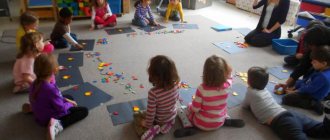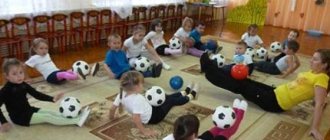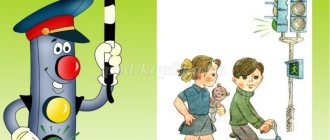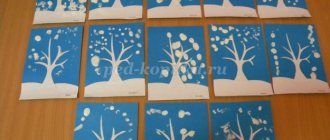Regular moments in the senior group in the afternoon
Summary of routine moments in the afternoon in the senior group “Forest Fairy Tale”.
MBDOU "Debesky kindergarten No. 1" Raising children
- Strengthen the ability to make a bed: straighten a sheet, cover it with a blanket;
- Improve the ability to dress and undress independently in a certain sequence;
- Formation of knowledge about a healthy lifestyle during awakening gymnastics;
Massage Mat
After the children begin to wake up, we begin awakening gymnastics. We use a complex of awakening gymnastics.
Preparing for afternoon tea
- develop self-service skills;
- Improve washing skills;
- form a CGN (wash hands before eating);
- Strengthen skills on duty: set the table with cutlery and dishes, napkins;
- To form the concept of a healthy lifestyle during rinsing and hygiene procedures in the bathroom.
Cups of salt water;
Teaching material: illustrations, board games
After all the girls have combed their hair, I suggest that all the guys brush their teeth and rinse their necks with a special solution of salt water. Goal: prevention of throat diseases.
I invite the dining room attendants to help set the table for afternoon tea.
Evening exercises after sleeping on the carpet, all together listening to music.
Evening circle. Children sit in a circle. Evening greeting. In a circle:
— finger gymnastics, “My Family”
One two three four
Who lives in our apartment?
Dad, mom, brother, sister, cat Murka, two kittens, my puppy, a cricket and me - that’s my whole family!
- articulation gymnastics,
“Smile” counting from 1 to 5 (hold)
“Tube” counting from 1 to 5 (hold)
Alternating “Smile”, “Tube”.
— Individual work with 5 children: pronouncing phrases,
didactic game for the development of speech and the formation of elementary mathematical concepts “Find the corresponding number and say it”
— physical education minute
Goal: getting children in the mood for the upcoming activity.
After the tables are set, I invite the children to wash their hands and come to the table.
I ask the children, what are we going to do now?, thereby fixing part of the day.
Afternoon snack
- improve skills: hold a fork with your thumb and middle finger, hold it on top with your index finger; eat different types of food without changing the position of the fork in your hand, but only slightly turning your hand.
- Improve the ability to cut a piece of cutlet (meat).
I remind you that you are not allowed to talk at the table.
When I eat
I don't listen to anyone
I pay attention to correct posture at the table while eating. Using my own example, I show you how to use cutlery correctly. I help the attendants read out the menu. I wish everyone a bon appetit.
I draw the children’s attention to the composition of the afternoon snack and the importance of each product for the child’s body (vitamins, minerals, etc.)
After an afternoon snack, I suggest rinsing your mouth with water. Purpose: preventive measure against caries.
Independent activities of children
Create conditions for the role-playing game “Shop”
- Control and observation of children during independent play activities.
Toys: dummies of vegetables and fruits, handbags, drawn money, cash register, counter, costumes for sellers, etc.
A gradual transition to the organization of a plot-role-playing game “Vegetable Store” or “Fruit Store” at the children’s choice. Offer the role of the seller to a low-active child in order to activate speech and communicate with peers, and perform the role until the end of the game. Buyers name the color and shape of an object in order to develop coherent speech. I pay attention to the children’s relationship with each other during the game.
Independent play activities for children in centers according to their wishes and interests.
Create conditions in the artistic corner:
- offer glue and scissors
- Goal: consolidation of application skills.
Ready-made templates and stencils, glue, scissors, visual material
I suggest some children do some applique work. As an example, I show an autumn leaf cut out of paper. I suggest choosing paper of any color you like and getting to work. I remind you that after working with glue you need to put everything back in its place.
Individual work with children
- Development of coordination of fine movements of the fingers
Sheet of paper and pencils
Game "Magic Pattern". I suggest coloring in view of the patterns. You need to decorate with pencils of different colors. I remind children how to hold a pencil correctly; do not go beyond the contours, etc.
Preparing for the walk
- Improve the ability to dress independently in a certain sequence;
- Strengthen the ability to properly place your things in the closet
- Educate KGN
I suggest the children go to the toilet. Let me remind you that boys come after girls.
Before going out to the locker room, we wait for “Silence”, then in such silence we get dressed gradually. I make sure that the children follow the sequence.
Exercise “Dress on command”: whoever is wearing tights and a sweater can wear pants. Now you can wear jackets and hats. Let me remind you that clothes need to be tucked inside to keep warm.
I give a positive assessment to children who dress correctly, quickly and quietly. I draw attention to those who need help.
Walk
Observation
- Form ideas about the autumn months;
- Learn to independently find signs of autumn in the environment;
- Systematize ideas about the state of plants in late autumn;
- vocabulary work: leaf fall, late autumn, short-term, herbarium;
While walking, I suggest that children observe seasonal changes in nature.
We highlight the weather features (in September it is colder than in August, rain, fog, the sun is shining but not warming). In November, late autumn sets in, there is snow on the ground.
We cultivate a caring attitude towards nature and plants.
Outdoor game “Tea-tea-help out”
(OVD - running)
- learn to act in harmony with each other.
- Learn to navigate in space
- Create positive emotions
I invite the children to gather in a circle and use a little counting rhyme:
On the golden porch sat the king, prince, king, prince, shoemaker, tailor, who are you, come out quickly, don’t detain good and honest people.
I'm getting the kids ready for a game. I remind you of the rules of the game. We choose a driver.
Individual work
- Sasha P – practice throwing at a target
Goal, ball
I suggest Sasha play “Hit the Target” ball. I explain how to hold and throw the ball. We train by doing several repetitions.
Goal: strengthening throwing skills.
Work assignments
- Learn to carry out the teacher's tasks
- Remove toys from the area
Broom, rake, gloves
Labor activity on site:
— Cleaning leaves;
— Sweeping on the veranda;
— We collect fallen leaves for the herbarium;
Working with parents
- Conversation about the child's achievements
When the children go home, I talk with the parents about the child’s achievements.
I suggest some parents pay attention to the child’s health, since he had a cough or runny nose during the day.
Basic principles of organizing the daily routine
Definition 1
Daily routine is a measured order of actions planned for the day.
While the child is in kindergarten, his life activities correspond to a regulated routine. The alternation of educational activities and outdoor games, rest and active wakefulness helps to avoid nervous fatigue in children.
Depending on their age, children are engaged in mastering certain self-service skills and learning to communicate culturally. It is important that in kindergarten the child not only develops, but also satisfies his need for active movements, nutrition, timely rest, etc.
Planning of routine moments in the middle group is based on studies of the physiology of children. Taking into account the age characteristics of the pupils. The basis of the regime are the following principles:
Are you an expert in this subject area? We invite you to become the author of the Directory Working Conditions
- rhythmicity - changing types of activities in accordance with internal cycles characteristic of children 4-5 years old;
- cyclicality – a constant schedule forms a habit and relieves nervous tension;
- alternation of rest and active pastime - throughout the day, outdoor games replace quiet activities, educational activities are replaced by artistic activities, and wakefulness is replaced by sleep;
- flexibility - when the child is tired, he should be able to retire. If he wakes up too early, he engages in quiet games with books and toys;
- gradualism - preschoolers should not be rushed, they should be given the opportunity to independently complete the work they have started;
- individual approach – some children may need additional help and special attention. The teacher must gradually include them in the general rhythm.
Classes
Activities with a two-year-old child may include:
- drawing with pencils or paints;
- modeling from salt dough or plasticine;
- Reading books;
- simple crafts, such as appliqués;
- cards with different objects or animals;
- sorting cereals and putting them into different containers;
- learning new words with an explanation of their meaning;
- getting help around the house.
Nutrition
A two-year-old eats at least 4 times a day, but if desired, you can add an additional meal, for example, in the form of a second light breakfast-snack between the main breakfast and lunch.
The diet should include the following products in certain quantities:
- wheat bread – 60-70 g
- rye bread – 30 g
- pasta or cereals (dry) – 40 g
- meat – 60-70 g
- fish – 60-70 g
- potatoes – up to 100-150 g
- other various vegetables – 150 g
- cottage cheese – up to 80-100 g
- milk – 200 g
- yogurt or kefir – 200 g
- cottage cheese – up to 100 g
- butter - a tablespoon;
- vegetable oil - a tablespoon;
- sour cream - a teaspoon;
- eggs – a whole small egg;
- dried fruits – 10-15 g
- hard cheese with a fat content of 45% - a five-gram piece.
Let's look at a sample menu for one day in the table:
| Eating | Dishes (examples) |
| Breakfast | 60 g steamed omelette, 150 g porridge cooked in milk, 150 ml tea or juice |
| Dinner | 100 ml of vegetable soup, steamed cutlet (60 g), 50 g of vermicelli, 50 g of seasonal vegetables (in the form of a salad dressed with sour cream or butter), 150 ml of compote (for example, from dried fruits) |
| Afternoon snack | 100 grams of yogurt or kefir, 50 g of cookies or rolls, fruit (apple, pear, peaches) |
| Dinner | 100 g mashed potatoes with butter, 100 g vegetable stew, 50 g fish (soufflé, cutlet) |
There is no longer a need for breastfeeding at two years old, but the mother can breastfeed if the baby needs it.
Walks
During walks, a two-year-old child must explore the world around him, contact and communicate with peers, recognize natural phenomena, examine objects and analyze the actions of other people, and also be sure to be physically active.
Important! Dress your baby according to the weather so that he does not freeze or sweat. Cancel walks when sick or in bad weather.
A competently and clearly organized daily routine for a two-year-old child will ensure the comfort of the whole family and help them learn discipline. And parents will be able to free up time for personal matters.
Development and education
At two years old, a child can do a lot: pronounce from 50 to 300 words, try to speak in short sentences, fulfill requests, express emotions, play without the participation of adults, ask to go to the potty (not always), eat food independently, dress or try to do this, repeat the movements and actions of adults, show and defend their desires, be actively interested in the world around them and communicate with peers, go down and up stairs, draw “doodles” and lines, dance and sing primitively (repeat the rhythm), try to disassemble and assemble objects, wipe hands and try to brush your teeth, actively participate in different games, and perform sequential complex actions.
Parenting includes the active involvement of the child in familiar everyday processes: dressing, hygiene procedures, preparing for meals, cleaning, and so on. Parents must also set boundaries and boundaries of what is permitted, stopping the child in case of incorrect or prohibited actions. Communication is very important, including discussing everything that is happening.
Physical activity
The physical development of a two-year-old is an important component of the regime. The baby is actively moving, but his coordination is not quite perfect yet. And this is important to consider when practicing games or any exercises. To develop dexterity, coordination and endurance, you can offer your child the following games and exercises:
- walking in place or in a straight line;
- jumping in place;
- squats, bends in different directions, back and forth;
- ball games;
- exercise “bicycle” in a lying position;
- dancing to rhythmic music;
- moving “in single file” (squatting);
- lifting objects from the floor;
- hanging on gymnastic rings.
Gymnastics should definitely be done in the morning. Also, physical activity at home is desirable if walking in the fresh air is not yet possible for some reason.
Games
At two years old, the following games and entertainment will be useful and interesting for the baby:
- role-playing games, including with dolls, sets for different professions;
- games with interactive toys;
- puzzles, sorters, busy boards,
- cubes, pyramids, construction sets with large parts;
- dancing, performing movements to music;
- hide and seek;
- singing.
Features of sleep of a two-year-old child
A two-year-old child should sleep about 13 hours a day. Approximately 10-11 hours are spent on night rest, and during the day the baby sleeps for about 2.5-3 hours, once. At two years old, another transition period may begin, along with which some sleep problems will come. The baby actively learns everything, develops and has fun, so he can go on vacation with whims, indignation and reluctance. Some psychologists call this behavior a false refusal to sleep.
A false refusal to rest may be a feature of emotional development, but sometimes it is provoked by the influence of certain factors, such as the absence or non-compliance with the daily routine, overwork or, conversely, the lack of activity and the possibility of an outburst of energy, overeating and abuse of sweets, an excited state or quarrels between parents, watching TV or games with smartphones and tablets.
Important! Be sure to observe your child’s behavior, because it indicates the need for rest. If the baby is lethargic, capricious, drowsy, irritable and yawns, it’s time for him to rest. But sometimes the decline in activity is preceded by a period of excitement, when the baby jumps, runs, screams and plays pranks. And such a surge of energy will likely be followed by an urgent need for a break, expressed in apathy, whims and yawning.
To improve night and daytime sleep, you should follow a few simple rules:
- Compliance with certain rituals - a sequence of actions preceding bedtime. This could be hygiene procedures, changing into pajamas, reading a fairy tale or singing a lullaby, dimming the lights, stroking the baby on the head. The ritual gives a feeling of calm and suggests that sleep will follow.
- Favorable atmosphere in the bedroom: temperature about 20-22 degrees, ventilated room, absence of loud sounds and noises, dim light.
- A walk before bed is advisable. It saturates the body with oxygen and relaxes.
- A burst of energy during the waking period. If the baby is tired enough (but not overtired!), then he will probably want to rest and quickly fall asleep.
- Preparing for bed in advance. Laying should not be done suddenly and abruptly. It is advisable to reduce activity half an hour to an hour before falling asleep and switch to quiet activities, eliminating all external stimuli (bright sunlight, sounds).
- Increasing the time interval between eating and sleeping. If the baby has just eaten a heavy meal, he will not be able to fall asleep quickly and soundly. You need to wait 30-60 minutes so that the food has time to partially digest.





